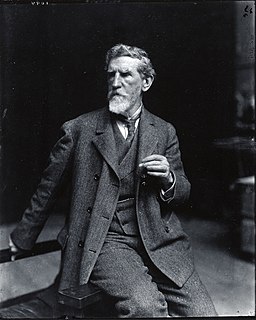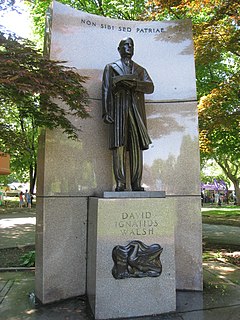
Thomas Ball was an American sculptor and musician. His work has had a marked influence on monumental art in the United States, especially in New England.

Augustus Saint-Gaudens was an American sculptor of the Beaux-Arts generation who embodied the ideals of the American Renaissance. From a French-Irish family, Saint-Gaudens was raised in New York City, he traveled to Europe for further training and artistic study. After he returned to New York, he achieved major critical success for his monuments commemorating heroes of the American Civil War, many of which still stand. Saint-Gaudens created works such as the Robert Gould Shaw Memorial on Boston Common, Abraham Lincoln: The Man, and grand equestrian monuments to Civil War generals: General John Logan Memorial in Chicago's Grant Park and William Tecumseh Sherman at the corner of New York's Central Park. In addition, he created the popular historicist representation of The Puritan.

Jo Davidson was an American sculptor. Although he specialized in realistic, intense portrait busts, Davidson did not require his subjects to formally pose for him; rather, he observed and spoke with them. He worked primarily with clay, while the final products were typically cast in terra-cotta or bronze, or carved from marble.

William Ordway Partridge was an American sculptor, teacher and author. Among his best-known works are the Shakespeare Monument in Chicago, the equestrian statue of General Grant in Brooklyn, the Pietà at St. Patrick's Cathedral in Manhattan, and the Pocahontas statue in Jamestown, Virginia.

Henry Hudson Kitson was an English-American sculptor who sculpted many representations of American military heroes.

Theo Alice Ruggles Kitson, also known as Tho. A. R. Kitson and Theo Alice Ruggles, was an American sculptor.

Walker Kirtland Hancock was an American sculptor and teacher. He created notable monumental sculptures, including the Pennsylvania Railroad World War II Memorial (1950–52) at 30th Street Station in Philadelphia, Pennsylvania, and the World War I Soldiers' Memorial (1936–38) in St. Louis, Missouri. He made major additions to the National Cathedral in Washington, DC, including Christ in Majesty (1972), the bas relief over the High Altar. Works by him are at the United States Military Academy, the Library of Congress, the United States Supreme Court Building, and the United States Capitol.

Brenda Putnam was an American sculptor, teacher and author.

Samuel Aloysius Murray was an American sculptor, educator, and protégé of the painter Thomas Eakins.

John Barry was an Irish-American officer in the Continental Navy during the American Revolutionary War and later in the United States Navy. He has been credited as "The Father of the American Navy" and was appointed a captain in the Continental Navy on December 7, 1775. He was the first captain placed in command of a U.S. warship commissioned for service under the Continental flag.

The Lapham Memorial is a public artwork by American artist Albert H. Atkins, located near the entrance to Lapham Hall, on the University of Wisconsin–Milwaukee campus. It is in memory of Increase A. Lapham, a 19th-century scientist famous for prompting the creation of the National Weather Service and recording the antiquities of Wisconsin, among other accomplishments.
Socrates is an outdoor sculpture by artist W. V. Casey created c. 1950. The work is on the grounds of Butler University in Indianapolis, Indiana, United States. The sculpture depicts the Greek Athenian philosopher Socrates. In 1993 the sculpture was examined by the Save Outdoor Sculpture! program produced by the Smithsonian Institution.

John Frazee was an American sculptor and architect. The Smithsonian has a collection of many of his sculptures as well as paintings of Frazee by other artists including Asher B. Durand and Henry Colton Shumway.

Pietro Montana was a 20th-century Italian-American sculptor, painter and teacher, noted for his war memorials and religious works.

George Washington was a life-size marble statue of George Washington, done in the style of a Roman general, by the Italian Neoclassical sculptor Antonio Canova. Commissioned by the State of North Carolina in 1815, it was completed in 1820 and installed in the rotunda of the North Carolina State House on December 24, 1821. The building and the statue were destroyed by fire on June 21, 1831. This work was the only one created by Canova for the United States.

A statue of Alexander Hamilton by William Rimmer is installed along Commonwealth Avenue, between Arlington and Berkeley Streets, in Boston, Massachusetts, United States.

Boston Common Tablet is a 1913 sculpture by R. Clipston Sturgis, installed at Boston Common in Boston, Massachusetts, United States.

Declaration of Independence Tablet is a 1925 sculpture by John Francis Paramino, installed at Boston Common, in Boston, Massachusetts, United States.

A statue of David I. Walsh by Joseph Coletti is installed along Boston's Charles River Esplanade, in the U.S. state of Massachusetts.

The Founders Memorial, also known as Founding of Boston, is a 1930 sculpture by John Francis Paramino, installed in Boston Common, in Boston, Massachusetts, United States.



















